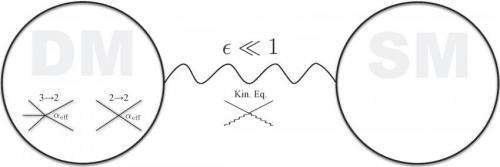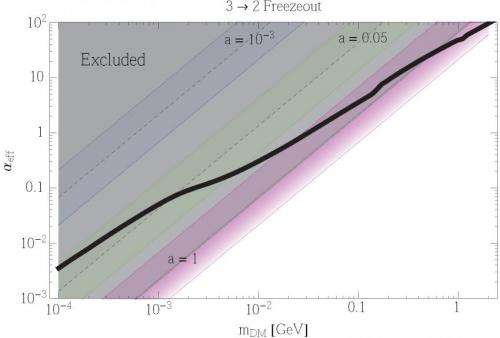December 2, 2014 feature
SIMP v WIMP: Novel thermal relic mechanism for dark matter creation in the early universe

(Phys.org)—Our current understanding of the universe is that the majority of its mass consists of dark matter (DM) – but there's a wrinkle: Despite having an idea about some of its properties – dark matter is cold, massive, has neither color nor electrical charge, and does not self-interact very strongly, so that it is detected through its gravitational interactions with ordinary matter and radiation – scientists don't know what dark matter actually is. That said, and as might well be expected, dark matter theories abound, one being that dark matter is a thermal relic from the early universe, in which all particles are in thermal equilibrium until expansion and cooling occurs. At that point, particle interaction rates slow, causing them to freeze-out – and while unstable particles vanish, stable particles reach what's known as their thermal relic density that remains. In this scenario, the most promising dark matter candidates are weakly interacting massive particles (WIMPs) – but even though extensions of the standard model often include such particles, no particle known today matches WIMP properties.
Recently, however, researchers at University of California, Berkeley, Tel Aviv University, Israel and Stanford University presented a new thermal relic dark matter mechanism which arises when a nearly secluded dark sector – a grouping of new particles that don't couple directly to the Standard Model – is thermalized (that is, attains thermal equilibrium) with the Standard Model after reheating. The new mechanism differs from previous thermal relics in proposing not WIMPs, but SIMPs (strongly interacting massive particles) as dark matter particle candidates, as well as implying that measurable signals will be observable with future indirect- and direct-detection experiments in the near future, as well as through dark matter production in next-generation colliders.
Dr. Yonit Hochberg discussed the paper that she and her co-authors Dr. Eric Kuflik, Dr. Tomer Volansky and Prof. Jay Wacker published in Physical Review Letters. "When people think about dark matter, what they often have in mind is the WIMP – a massive particle mass around 1-1,000 times the mass of the proton that weakly interacts with itself and other particles," Hochberg tells Phys.org. "In this picture, the relic population of dark matter particles in our universe today is produced by what is termed a 2 → 2 process in which two dark matter particles collide and annihilate, generating two ordinary matter particles." Hochberg adds that the rate at which this process occurs depends in part on how strongly dark and regular matter interact, in that interaction strength and process rate vary directly. "Such WIMP dark matter particles have been the dominant candidate for dark matter for the last 35 years," she continues. "Although we've been searching for these WIMPs in a variety of different ways, we still haven't found them – so it's important to use our imagination: What would happen if the dark matter was really secluded from the visible ordinary particles? Can a thermal relic population of dark matter still exist? What would its mass be? How would it interact with ordinary matter?"
Hochberg points out that if dark matter really is secluded from visible matter, a mechanism that can change the number of dark matter particles is a 3 → 2 process, in which when three dark matter particles collide and produce two dark matter particles. What's important is that this process doesn't depend on interactions between the dark and regular matter; rather, it depends entirely on the self-interaction strength and number of the dark matter particles themselves to determine whether or not the collision takes place. For dark matter particles that interact with each other almost as strongly as quarks interact with themselves, and that have mass between the proton mass a 1/1000 the proton mass, this 3→2 process will leave a relic dark matter population in the universe today in agreement with observations.
"However," Hochberg says, "this 3 → 2 process heats up the dark matter such that it can't be completely secluded from ordinary matter. The dark matter particles must be able to interact with other particles in order to cool themselves, meaning that there have to be interactions between dark and ordinary matter." A dark matter candidate of this sort – a SIMP – is vastly lighter than the WIMP, and interacts strongly with itself and weakly with ordinary matter. "One might worry that if the dark matter cools itself by interacting with the visible matter, then the dark matter might also be able to annihilate itself away into ordinary matter through these same interactions. If this were the case we'd be back to WIMPs, so the question is Can dark matter cool but not annihilate?
"A priori," Hochberg reasons, "the same interactions that cool dark matter enable it to annihilate into ordinary matter. However, the key is that the rate of a process depends not only on the strength of the interaction between the particles, but also on how abundant the colliding particles are. For dark matter to cool, it has to scatter off of ordinary matter, which is abundant, while for dark matter to annihilate, it has to interact with another dark matter particle, of which there aren't that many." In other words, during the early universe dark matter could cool by transferring heat into ordinary matter without annihilating into it because there were many more photons, electrons and neutrinos than dark matter – so if dark matter interacts with these particles it can cool without annihilating. "The strength of this interaction is small, but not arbitrarily small," Hochberg adds. "If this interaction is too weak, dark matter can't cool itself sufficiently; if this interaction is too strong, annihilation of dark matter into ordinary matter is more important than the 3 → 2 self-annihilations and we're back to WIMPs. SIMP dark matter therefore requires sizable interactions in a particular range between dark and ordinary matter – interactions that can be probed by current and upcoming experimental efforts."

The paper characterizes the proposed SIMP mechanism as a new dark matter paradigm rather than a specific dark matter candidate, pointing toward the next step: exploring models for the SIMP mechanism. "We've presented a novel idea for the identity of dark matter, termed the SIMP mechanism," Hochberg says. "In a more recent paper written in collaboration with Hitoshi Murayama1, we've identified classes of strongly coupled theories that give explicit realizations of SIMP dark matter." Interestingly, these are theories of dynamical chiral symmetry breaking resembling quantum chromodynamics (QCD) – the theory of strong interactions between quarks and gluons, the elements of hadrons such as protons, neutrons and pions – in which pions play the role of dark matter. "These theories generically have interactions between five dark matter particles, and so the important SIMP annihilation of three dark matter particles into two dark matter particles exists." These annihilations are the dark matter equivalent of two kaons annihilating into three pions in quantum chromodynamics. "In addition, the pions also scatter off themselves, altering predictions of structure formation in the universe. These theories are a simple and calculable realization of the SIMP mechanism."

Hochberg says that there are two necessary ingredients for SIMP dark matter: dark matter particles must interact strongly with themselves, which she stresses is crucial for the 3 → 2 self-annihilations of dark matter needed to explain the observed amount of dark matter today; and dark matter must interact weakly, but not too weakly, with ordinary matter, which ensures that dark matter can cool itself but not annihilate into ordinary particles. "These two key features of the SIMP mechanism imply measurable signals on many experimental frontiers that will probe this new paradigm with current and future data. Moreover, these signals are not forced into the model, but rather occur naturally. "For example," she illustrates, "the strong self-interactions of dark matter particles unavoidably give rise to distorted galaxy shapes – a prediction supported by data."
In addition, she notes, the non-negligible interactions between dark matter and ordinary matter dictate measurable signals in a variety of avenues:
- Direct detection of dark matter, where electron ionization signals should be looked for, rather than nuclear recoil signals that are relevant in the search for WIMPs
- Indirect detection via telescopes measuring gamma ray fluxes
- Cosmological searches constraining imprints on the cosmic microwave background and on big bang nucleosynthesis
- Colliders such as the Large Electron-Positron (LEP) collider – the largest electron-positron accelerator ever built, which was dismantled in 2000 and whose tunnel now hosts the LHC – where SIMP dark matter could have been produced when electrons and positrons smashed into each other
"We're just starting to explore the rich phenomenology of this new paradigm for dark matter" Hochberg tells Phys.org. "In our more recent paper, we found explicit classes of strongly coupled theories that naturally have SIMPs in them, and are now working on the explicit realizations of the interactions between dark and ordinary matter. Depending on the particular way in which the dark matter cools itself through these interactions, different additional experimental signals can emerge."
Hochberg and her colleagues also want to understand why the SIMP mechanism mass scale is so close to that of quantum chromodynamics. "Could there be a common origin? How can 3 → 2 processes be detected on earth? We're working towards answering all these questions."
More information: Mechanism for Thermal Relic Dark Matter of Strongly Interacting Massive Particles, Physical Review Letters (2014) 113:171301, doi.org/10.1103/PhysRevLett.113.171301
Related:
1The SIMPlest Miracle, (13 Nov 2014) arXiv:1411.3727v1 (PDF)
Journal information: Physical Review Letters
© 2014 Phys.org



















